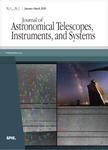版权所有:内蒙古大学图书馆 技术提供:维普资讯• 智图
内蒙古自治区呼和浩特市赛罕区大学西街235号 邮编: 010021

作者机构:University of Canterbury Department of Chemical and Process Engineering Christchurch New Zealand University of Canterbury Department of Electrical and Computer Engineering Christchurch New Zealand
出 版 物:《Journal of Astronomical Telescopes, Instruments, and Systems》 (J. Astron. Telesc. Instrum. Syst.)
年 卷 期:2025年第11卷第1期
核心收录:
学科分类:070207[理学-光学] 07[理学] 070401[理学-天体物理] 0803[工学-光学工程] 0704[理学-天文学] 0702[理学-物理学]
摘 要:This paper studies the geometric wavefront sensor (WFS) as part of the development of an astronomical imaging instrument for the University of Canterbury Mount John Observatory, which combines adaptive optics and computer post-processing techniques for astronomical observations over a wide field of view by utilizing the geometric WFS and atmospheric tomography. Specifically, this paper investigate the geometric WFS s capability to estimate wavefronts of multiple artificial guide stars, as well as to demonstrate atmospheric tomography, on a modified optical test bench in an open loop. A technique to simulate atmospheric turbulence in the laboratory is explored and is found to suitably create multiple atmospheric layers artificially;this technique permits wavefront phase aberrations of multiple artificial guide stars to be simulated simultaneously with varying degrees of overlap (i.e., changing the altitude of the atmospheric turbulence layer, or atmospheric tomography metapupil) without altering the physical optical path. Atmospheric tomography is then physically demonstrated on the modified optical test bench using the technique and calibrated geometric WFS. © 2025 Society of Photo-Optical Instrumentation Engineers (SPIE).